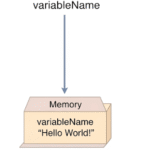JavaScript Variables: Declaring and Understanding Data
In the JavaScript language, variables serve as essential containers for storing data values. Just like in other programming languages, JavaScript variables are the fundamental building blocks that allow you to hold and manipulate information within your scripts. Properly declaring and using variables is crucial for writing dynamic and functional client-side code that interacts with user input, processes information, and updates web page content. This section will delve into how these JavaScript variables are declared, the rules for naming them, and the basic data types they can hold.
What are Variables in JavaScript?
A variable in JavaScript is a named storage location that holds a value. Think of it as a labeled box where you can put different kinds of data. These values can change during the execution of a program, hence the term “variable”. They are declared before they are used in a program. Understanding JavaScript variables begins with grasping this concept of a named container.
Think of it as a labeled box where you can put different kinds of data. These values can change during the execution of a program, hence the term “variable”. They are declared before they are used in a program. Understanding JavaScript variables begins with grasping this concept of a named container.
Declaring JavaScript Variables: The var Keyword
In JavaScript, variables are traditionally declared using the var keyword. The var keyword signals to the JavaScript engine that you are creating a new variable. While modern JavaScript introduces let and const for variable declaration, var remains a fundamental concept used in many existing scripts, especially when exploring older codebases. Effectively declaring JavaScript variables with var is a core skill.
The basic syntax for declaring a variable is:
var variableName;
You can also assign a value to the variable immediately upon declaration:
var message = "Hello, JavaScript!";
var userAge = 30;
Here, message and userAge are JavaScript variables storing a string and a numeric value, respectively. This demonstrates the simplicity of declaring and initializing JavaScript variables.
JavaScript Variable Naming Rules
To declare JavaScript variables effectively, you must follow specific naming conventions:
- Start with a Letter, Underscore, or Dollar Sign: A variable name must begin with a letter (A-Z or a-z), an underscore (
_), or a dollar sign ($). - Subsequent Characters: After the first character, you can use letters, digits (0-9), underscores, or dollar signs.
- Case-Sensitivity: JavaScript is case-sensitive, meaning
myVariableandmyvariableare treated as two different JavaScript variables. This is a common source of bugs if not remembered. - Reserved Keywords: You cannot use JavaScript reserved keywords (like
var,function,if,else, etc.) as variable names. Attempting to do so will result in a syntax error.
Here are some examples of valid and invalid JavaScript variables names:
// Valid variable names
var firstName = "John";
var _lastName = "Doe";
var $price = 99.99;
var quantity1 = 100;
var my_variable_name = "example"; // Another valid JavaScript variable name
// Invalid variable names (will cause errors)
// var 1stName = "Invalid"; // Cannot start with a digit
// var my-variable = "Invalid"; // Hyphens are not allowed, interpreted as subtraction
// var function = "Invalid"; // 'function' is a reserved keyword
Basic Data Types for JavaScript Variables
JavaScript variables can hold various types of data. JavaScript is a dynamically typed language, meaning you do not have to explicitly declare the data type of a variable when you declare it. The JavaScript engine automatically determines the data type based on the value assigned to the variable. The primary data types covered in the provided materials include:
- Numeric: Used for both integer and floating-point numbers.JavaScript
var score = 100; // Integer numeric variable var pi = 3.14159; // Floating-point numeric variable - String: Used for sequences of characters, enclosed in single or double quotes.JavaScript
var greeting = "Welcome!"; // String variable var userName = 'Alice'; // Another string variable - Boolean: Represents a logical entity and can only have two values:
trueorfalse. These are crucial for conditional logic.JavaScriptvar isActive = true; // Boolean variable set to true var isLoggedIn = false; // Boolean variable set to false - Null: Represents the intentional absence of any object value. It is one of JavaScript’s primitive values, signifying “no value.”JavaScript
var emptyValue = null; // A JavaScript variable with a null value
Assigning Values to JavaScript Variables
Once a variable is declared, you can assign a value to it using the assignment operator (=). You can also change the value of a JavaScript variable at any point after its initial assignment, making them highly flexible.
var item; // Variable declared, its initial value is 'undefined'
item = "Laptop"; // Value assigned to the JavaScript variable 'item'
document.writeln("The item is: " + item); // Output: The item is: Laptop
item = "Mouse"; // Value re-assigned to the JavaScript variable 'item'
document.writeln("The updated item is: " + item); // Output: The updated item is: Mouse
Re-declaring and Re-assigning var Variables
With the var keyword, it’s possible to re-declare a variable without causing an error, although this practice is generally not recommended in modern JavaScript as it can lead to confusion and unintended side effects, especially in larger codebases. Understanding how var handles re-declaration is key to comprehending older JavaScript code.
var product = "Tablet";
document.writeln("Product 1: " + product); // Output: Product 1: Tablet
var product = "Smartphone"; // Re-declaring the JavaScript variable 'product'
document.writeln("Product 2: " + product); // Output: Product 2: Smartphone
In this example, re-declaring product simply overwrites its previous value without any warning. For modern JavaScript development, newer keywords like let and const offer more robust control over variable scope and re-assignment, which helps in preventing such unintended re-declarations and improving code predictability. However, as the provided material focuses on var, it’s essential to understand its behavior.
